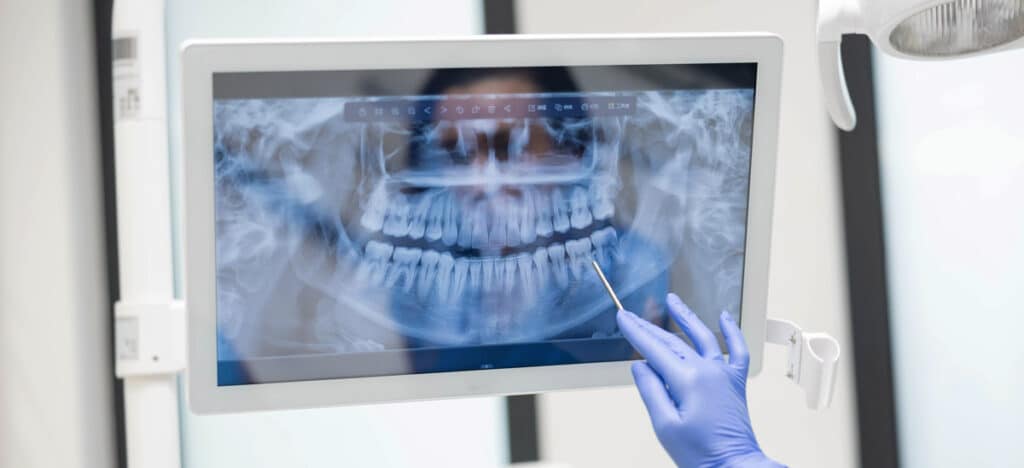How to stop tooth decay in its tracks

Tooth decay is one of the most common dental problems affecting people of all ages. Left untreated, it can lead to discomfort, tooth pain, and even tooth loss.
But here’s the good news: with the right knowledge and habits, you can prevent tooth decay and stop it in its tracks.
This comprehensive guide will walk you through everything you need to know about tooth decay, from recognising early signs to professional treatments, dietary tips, and home care.
Whether you’re dealing with early-stage tooth decay or want to protect your teeth for the long term, this blog is your go-to resource.

What is tooth decay?
Tooth decay, also known as dental caries, is a process where decay-causing bacteria in your mouth attack the enamel surface of your teeth.
These bacteria form a sticky layer called dental plaque, which clings to the tooth surface. When you consume sugary drinks, carbohydrates, or foods, the bacteria feed on these sugars and release acids that erode tooth enamel.
If left unchecked, tooth decay advances into deeper layers of the tooth, causing cavities, pain, and potentially more severe issues like a dental abscess.
Understanding tooth decay
How does tooth decay develop?
Tooth decay is the result of a bacterial infection in your mouth. Bacteria in dental plaque produce acid after feeding on sugars from foods and drinks.
This acid gradually depletes the minerals in your enamel, leading to a weakened enamel surface.
If decay-causing bacteria are not removed, they continue to attack the tooth. Eventually, they penetrate deeper into the tooth root and the blood vessels within the pulp.
Stages of tooth decay
Early tooth decay: In this stage, the enamel begins to lose minerals, often appearing as white spots. These can often be remedied with fluoride treatments and improved dental hygiene.
Dental cavity formation: If untreated, the enamel breaks down further, leading to pits and fissures or visible holes in the tooth. These cavities may require fillings to restore the tooth.
Tooth root damage: The decay advances to the dentin layer, which connects to the tooth root. You may notice significant tooth pain and sensitivity at this stage.
Severe tooth decay: If the decay reaches the pulp, which contains nerves and blood vessels, a dental abscess can form, causing severe mouth pain.
Common causes of tooth decay
Tooth decay develops as a result of several factors, and understanding these causes can help you take preventative steps to protect your oral health.
Plaque
A leading cause of tooth decay is poor oral hygiene. When brushing and flossing are neglected or performed inconsistently, a sticky film of bacteria on teeth called dental plaque accumulates on the tooth surface.
This plaque harbours decay-causing bacteria that produce acids, which erode the enamel and lead to cavities. Without proper brushing and flossing, these bacteria thrive.
Sugar
Another significant contributor to tooth decay is a diet high in sugary drinks and sticky snacks. Foods and beverages with a high sugar content fuel the bacteria in dental plaque, enabling them to produce even more harmful acids.
Sticky foods, like caramel or chewy sweets, are particularly problematic. This is because they cling to the teeth, prolonging acid exposure and accelerating the decay process. Frequent snacking or sipping on sugary drinks throughout the day can exacerbate the issue, as it creates a constant acid attack on the enamel.
Low saliva
Reduced saliva production is another often-overlooked cause of tooth decay. Saliva plays a critical role in neutralising acids, washing away food particles, and supplying the minerals needed to repair early-stage enamel damage.
When saliva production is limited, the mouth becomes more vulnerable to tooth decay. This dry environment provides ideal conditions for decay-causing bacteria to thrive and attack the enamel.
Difficult to clean teeth
Finally, the natural structure of your teeth can also make them more susceptible to decay. Deep grooves and fissures in the chewing surfaces of back teeth are particularly challenging to clean with a toothbrush.
These areas can trap food particles and harbour bacteria, creating an environment where dental plaque can accumulate, and tooth decay can develop.
Even with excellent oral hygiene habits, these hard-to-reach surfaces are more prone to cavities without additional protective measures, such as dental sealants.
Recognising the early signs
Being able to identify tooth decay in its early stages is crucial for preventing it from progressing into more severe dental problems. Identifying the warning signs early on allows you to take action and seek treatment before the damage becomes extensive.
Sensitivity
One of the most common early signs of tooth decay is sensitivity to hot, cold, or sweet foods and drinks. If you notice occasional sharp pain or discomfort while enjoying a cup of tea, eating ice cream, or consuming sugary treats, it could be a sign that your enamel is starting to wear down.
As the protective layer of enamel thins, the sensitive dentin underneath becomes exposed, leading to these uncomfortable sensations. While occasional sensitivity may seem minor, it should not be ignored, as it could indicate the beginning of a cavity or enamel erosion.
Discolouration
Another visible indicator of tooth decay is the appearance of discoloured spots on the teeth. These may start as white spots, which signal areas of demineralisation where the enamel is losing minerals.
As the decay progresses, these spots may turn brown or black, highlighting the affected areas where damage has worsened.
If you notice any unusual discolouration, it’s important to consult a dental professional as soon as possible. Early treatment can often reverse the damage and restore the health of your enamel before the decay develops into a more serious problem, such as a cavity or tooth abscess.
By staying vigilant and acting on these early signs, you can stop tooth decay in its tracks and protect your teeth from further damage.
Tooth decay and children
Tooth decay is a common concern for young children, particularly during the early years when baby teeth, also known as primary teeth, are still developing. These first teeth play a crucial role in a child’s overall health and well-being, acting as placeholders for adult teeth and aiding in speech and chewing. However, they are more vulnerable to decay than many parents realise.
One issue often encountered is baby bottle tooth decay, which occurs when a child’s teeth are frequently exposed to sugary drinks or milk for prolonged periods, particularly during bedtime. The natural sugars in milk or formula can linger on the teeth, creating an ideal environment for bacteria to thrive.
Left untreated, decay in baby teeth can lead to pain, infection, and even issues with the alignment of a child’s permanent teeth. Early intervention is key, as dental health in childhood lays the foundation for a healthy adult smile.
How to avoid tooth decay
Preventing tooth decay is a lifelong endeavour, and the strategies you use may differ depending on your age or stage in life. By tailoring preventative measures to specific age groups, you can ensure oral health at every stage, from childhood to older adulthood.
Protecting children’s teeth
Tooth decay in children is a widespread issue, but with the right habits, it’s entirely preventable. Children’s teeth are particularly vulnerable because their enamel is thinner than that of adults. Starting good oral hygiene practices early is key to ensuring healthy teeth and gums as they grow.
Brushing
From the time a child’s first tooth emerges, parents should establish a consistent brushing routine. Even baby teeth, also known as primary teeth, play a vital role in a child’s oral development, as they help with chewing, speech, and maintaining proper spacing for permanent teeth.
Use fluoride toothpaste in an age-appropriate amount (a smear for children under three and a pea-sized amount for those aged three to six). Fluoride strengthens the enamel, making it more resistant to acid attacks from decay-causing bacteria.
Diet
Diet also plays a major role in preventing cavities in children. Limit sugary snacks, fizzy drinks, and sticky sweets that cling to the teeth. Instead, offer tooth-friendly options such as fresh fruits, vegetables, cheese, and yoghurt.
Drinking water throughout the day helps rinse away food particles and bacteria, keeping the mouth clean. In areas with fluoridated tap water, drinking from the tap offers the added benefit of strengthening tooth enamel.
Regular dental check-ups
Finally, early dental care is crucial. Schedule your child’s first dental visit by their first birthday or as soon as their first tooth appears. Early visits allow dentists to monitor oral development, provide fluoride treatments, and offer guidance on proper brushing and flossing techniques.
Dental professionals can also apply dental sealants to protect the chewing surfaces of back teeth, which are more prone to cavities due to their deep grooves and fissures. Establishing a positive relationship with the dentist early on helps children feel comfortable with dental visits, making oral care a normal part of their routine.
Caring for teeth in older adults
Oral health challenges often increase with age, making preventative care especially important for older adults. Issues such as receding gums, dry mouth, and dental decay are more common in this group, requiring a proactive approach to maintain oral health and prevent complications.
Receding gums
Receding gums, a condition where the gum tissue pulls back from the teeth, exposes the tooth root, making it more vulnerable to decay and sensitivity. This condition is often caused by years of wear and tear or gum disease.
Maintaining good oral hygiene and using a soft-bristled toothbrush can help minimise further gum recession. In some cases, dentists may recommend specialised treatments, such as fluoride gel or varnish, to protect exposed tooth roots from decay.
Dry mouth
Dry mouth, or xerostomia, is another common issue among older adults, often resulting from medications or underlying health conditions. Saliva plays a critical role in neutralising acids, washing away food particles, and remineralising enamel. Without adequate saliva production, the risk of cavities and gum disease increases.
Staying hydrated, using artificial saliva products, and chewing sugar-free gum can help alleviate dry mouth symptoms and improve oral health.
Dental check-ups
Older adults are also more likely to experience dental decay, particularly around old fillings, crowns, or bridges. Regular dental visits are essential for detecting and addressing these issues early.
Dentists can recommend fluoride treatments to strengthen enamel and protect against decay. For individuals at higher risk of cavities, dental sealants can be applied to back teeth to safeguard their chewing surfaces.
Caring for restorative dentistry work
For those with missing teeth, proper dental care is just as important. Dentures, bridges, or dental implants must be cleaned and maintained to prevent plaque buildup and gum infections. Regular check-ups allow dental professionals to assess the fit of dentures or other prosthetics and address any potential problems.
Nutrition
Lastly, nutrition plays a vital role in oral health for older adults. A balanced diet rich in calcium, vitamin D, and other nutrients supports strong teeth and gums. Minimising sugary foods and drinks helps reduce the risk of decay-causing bacteria, while drinking fluoridated water provides additional protection against cavities.
By prioritising oral hygiene, seeing a dentist regularly, and making informed dietary choices, older adults can preserve their oral health and avoid complications such as tooth loss or gum disease. Taking these preventative measures ensures a better quality of life and maintains confidence in one’s smile.
Tooth decay treatment
When tooth decay advances beyond the enamel and affects the dentin, more involved dental treatment becomes necessary. At this stage, cavities, or dental caries, have formed, and the decay cannot be reversed through remineralisation. Instead, the affected tooth will need to be restored using various methods, depending on the severity of the decay.
- Fillings: Dental fillings are the most common treatment for cavities. The dentist removes the decayed portion of the tooth and fills the space with a restorative material such as composite resin, amalgam, or ceramic. Composite fillings are often preferred for their natural appearance, as they blend seamlessly with the colour of the tooth. This treatment restores the tooth’s function and prevents further decay by sealing off the cavity.
- Inlays and onlays: If the decay is too extensive for a standard filling but not severe enough to require a crown, the dentist may recommend an inlay or onlay. These are custom-made restorations that are bonded to the tooth, providing additional strength and durability. Inlays are used for smaller cavities within the tooth’s surface, while onlays extend to cover the chewing surfaces or cusps of the tooth.
- Dental crowns: When decay severely damages a tooth, leaving it weak or structurally compromised, a crown may be necessary. A dental crown, sometimes called a cap, covers the entire visible portion of the tooth, restoring its shape, size, and strength. Crowns are often made of porcelain, ceramic, or metal, depending on the tooth’s location and the patient’s preferences.
Root canal treatment
If tooth decay reaches the innermost layer of the tooth, called the pulp, it can cause intense tooth pain and lead to an infection.
At this point, a root canal treatment is often the only way to save the tooth. During a root canal, the dentist removes the infected pulp, cleans and disinfects the root canals, and seals them with a filling material.
The tooth can then be restored with a crown to protect it from further damage. Root canal therapy can effectively eliminate pain and save the affected tooth from extraction.
Treating severe decay and tooth loss
When tooth decay progresses to the point where the tooth is severely damaged and cannot be saved, extraction may be necessary. Once the tooth is removed, the dentist will discuss replacement options to restore functionality and aesthetics.
- Dental implants: A dental implant is a permanent solution for replacing a missing tooth. It consists of a titanium post inserted into the jawbone, which serves as an artificial root. Once the implant fuses with the bone, a crown is placed on top to replicate the appearance and function of a natural tooth.
- Bridges: A dental bridge is another option for replacing one or more missing teeth. It involves anchoring an artificial tooth (or teeth) to the neighbouring natural teeth or dental implants. Bridges are a less invasive alternative to implants but still provide excellent functionality and aesthetics.
- Dentures: For patients missing multiple teeth, partial or full dentures may be recommended. Dentures are removable prosthetics that restore the appearance of a complete set of teeth and improve the ability to eat and speak.
Why it’s important to act quickly
Tooth decay doesn’t go away on its own. In its early stages, it may cause no symptoms, but as it progresses, you may experience tooth sensitivity, occasional sharp pain, or visible damage.
Ignoring it can result in more extensive dental treatment, including root canal therapy, tooth fillings, or even tooth loss.
Early treatment not only prevents further damage but also saves money in the long term. After all, private dental treatment varies in cost, and complex procedures can become expensive.
Preventing further decay after treatment
After receiving tooth decay treatment, maintaining good oral hygiene is essential to prevent future problems. Regular brushing and flossing, combined with fluoride toothpaste, help protect teeth from plaque buildup.
Visiting the dentist regularly for check-ups and professional cleanings ensures that any new signs of decay can be addressed early.
For individuals with a history of frequent cavities or extensive dental work, dentists may recommend additional preventative measures, such as fluoride varnishes, dental sealants for back teeth, or prescription-strength fluoride products. These treatments help fortify enamel and protect vulnerable areas from further decay.
By addressing tooth decay at every stage, modern dentistry offers effective solutions to restore oral health and prevent complications, ensuring patients can enjoy a healthy, confident smile.
Fulham Road Dental: your trusted dental practice in the fight against tooth decay
Maintaining optimal oral health is a lifelong commitment that requires diligent daily care and regular professional attention. By understanding the causes and progression of tooth decay, recognising early warning signs, and implementing effective preventative measures tailored to each life stage, you can significantly reduce the risk of dental issues.
Regular dental check-ups are essential for early detection and management of potential problems. At Fulham Road Dental, we offer comprehensive general dentistry services, including routine examinations, cleanings, and preventative treatments, to help you maintain a healthy smile.
Remember, proactive dental care not only preserves your teeth but also contributes to your overall well-being. By staying informed and engaged in your oral health, you can prevent tooth decay and enjoy a lifetime of confident smiles.




